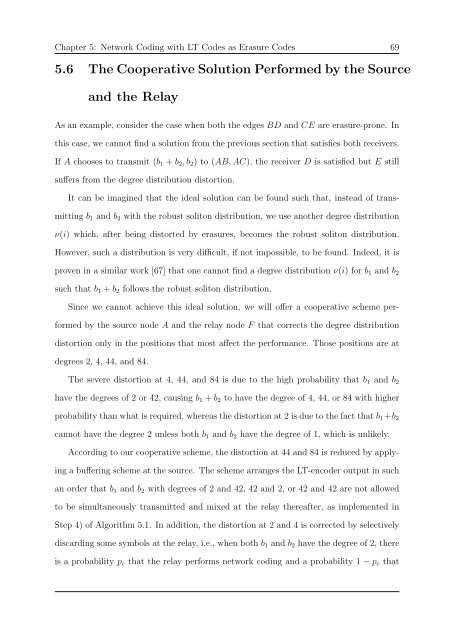Network Coding and Wireless Physical-layer ... - Jacobs University
Network Coding and Wireless Physical-layer ... - Jacobs University
Network Coding and Wireless Physical-layer ... - Jacobs University
You also want an ePaper? Increase the reach of your titles
YUMPU automatically turns print PDFs into web optimized ePapers that Google loves.
Chapter 5: <strong>Network</strong> <strong>Coding</strong> with LT Codes as Erasure Codes 69<br />
5.6 The Cooperative Solution Performed by the Source<br />
<strong>and</strong> the Relay<br />
As an example, consider the case when both the edges BD <strong>and</strong> CE are erasure-prone. In<br />
this case, we cannot find a solution from the previous section that satisfies both receivers.<br />
If A chooses to transmit (b 1 + b 2 , b 2 ) to (AB, AC), the receiver D is satisfied but E still<br />
suffers from the degree distribution distortion.<br />
It can be imagined that the ideal solution can be found such that, instead of transmitting<br />
b 1 <strong>and</strong> b 2 with the robust soliton distribution, we use another degree distribution<br />
ν(i) which, after being distorted by erasures, becomes the robust soliton distribution.<br />
However, such a distribution is very difficult, if not impossible, to be found. Indeed, it is<br />
proven in a similar work [67] that one cannot find a degree distribution ν(i) for b 1 <strong>and</strong> b 2<br />
such that b 1 + b 2 follows the robust soliton distribution.<br />
Since we cannot achieve this ideal solution, we will offer a cooperative scheme performed<br />
by the source node A <strong>and</strong> the relay node F that corrects the degree distribution<br />
distortion only in the positions that most affect the performance. Those positions are at<br />
degrees 2, 4, 44, <strong>and</strong> 84.<br />
The severe distortion at 4, 44, <strong>and</strong> 84 is due to the high probability that b 1 <strong>and</strong> b 2<br />
have the degrees of 2 or 42, causing b 1 + b 2 to have the degree of 4, 44, or 84 with higher<br />
probability than what is required, whereas the distortion at 2 is due to the fact that b 1 +b 2<br />
cannot have the degree 2 unless both b 1 <strong>and</strong> b 2 have the degree of 1, which is unlikely.<br />
According to our cooperative scheme, the distortion at 44 <strong>and</strong> 84 is reduced by applying<br />
a buffering scheme at the source. The scheme arranges the LT-encoder output in such<br />
an order that b 1 <strong>and</strong> b 2 with degrees of 2 <strong>and</strong> 42, 42 <strong>and</strong> 2, or 42 <strong>and</strong> 42 are not allowed<br />
to be simultaneously transmitted <strong>and</strong> mixed at the relay thereafter, as implemented in<br />
Step 4) of Algorithm 5.1. In addition, the distortion at 2 <strong>and</strong> 4 is corrected by selectively<br />
discarding some symbols at the relay, i.e., when both b 1 <strong>and</strong> b 2 have the degree of 2, there<br />
is a probability p c that the relay performs network coding <strong>and</strong> a probability 1 − p c that

















